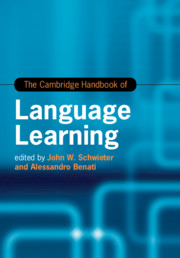Book contents
- The Cambridge Handbook of Language Learning
- Cambridge Handbooks in Language and Linguistics
- The Cambridge Handbook of Language Learning
- Copyright page
- Contents
- Figures
- Tables
- Contributors
- Acknowledgements
- Introduction
- Part I Theories
- 1 Formal Linguistic Approaches to Adult L2 Acquisition and Processing
- 2 Cognitive Approaches to Second Language Acquisition
- 3 The Qualitative Science of Vygotskian Sociocultural Psychology and L2 Development
- 4 Theoretical Frameworks in L2 Acquisition
- Part II Methods
- Part III Skill Development
- Part IV Individual Differences
- Part V Pedagogical Interventions and Approaches
- Part VI Context and Environment
- Part VII Moving Forward
- Index
- References
3 - The Qualitative Science of Vygotskian Sociocultural Psychology and L2 Development
from Part I - Theories
Published online by Cambridge University Press: 25 June 2019
- The Cambridge Handbook of Language Learning
- Cambridge Handbooks in Language and Linguistics
- The Cambridge Handbook of Language Learning
- Copyright page
- Contents
- Figures
- Tables
- Contributors
- Acknowledgements
- Introduction
- Part I Theories
- 1 Formal Linguistic Approaches to Adult L2 Acquisition and Processing
- 2 Cognitive Approaches to Second Language Acquisition
- 3 The Qualitative Science of Vygotskian Sociocultural Psychology and L2 Development
- 4 Theoretical Frameworks in L2 Acquisition
- Part II Methods
- Part III Skill Development
- Part IV Individual Differences
- Part V Pedagogical Interventions and Approaches
- Part VI Context and Environment
- Part VII Moving Forward
- Index
- References
Summary
Since the early papers of Frawley and Lantolf (1985; Lantolf & Frawley, 1984), Vygotskian psychology, often referred to as sociocultural theory (SCT), has gained prominence as one of several “mainstream” (Swain & Deters, 2007) or “alternative” (Atkinson, 2011) second language acquisition (SLA) theories. A central concern of the general theory is how sign systems (e.g., language, literacy, numeracy) are internalized to reorganize basic, or biologically endowed, psychological functions into higher, or culturally mediated, ones, which give rise to consciousness. In particular, Vygotsky (1986) focused on the role of language in constituting higher mental functions: language does not simply facilitate cognition, but it is part and parcel of it. In this way, Vygotsky’s semiotic analysis of consciousness and word meaning connects him not only to Marxian dialectical materialism, but also to the German psycholinguistic tradition inspired by such scholars as Hegel and Herder, as Leitch (2011) has pointed out: “Human consciousness is formed through linguistic interactions, and the language which constitutes consciousness is therefore always part of it, unable to be separated” (p. 306).
- Type
- Chapter
- Information
- The Cambridge Handbook of Language Learning , pp. 62 - 83Publisher: Cambridge University PressPrint publication year: 2019
References
- 3
- Cited by



